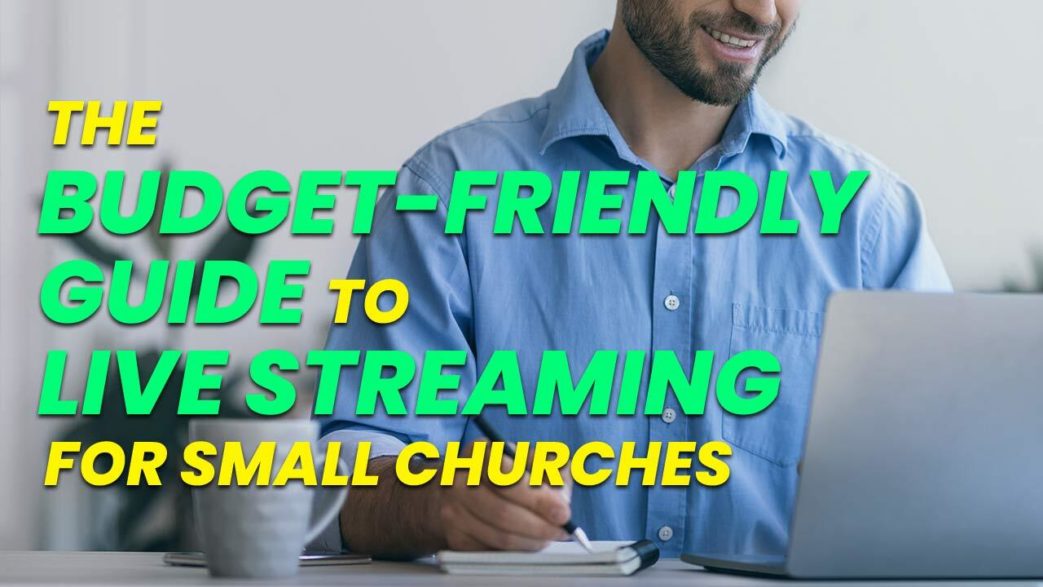Estimated reading time: 10 minutes
Live streaming for small churches boosts growth, increases an online following and helps more members attend regularly. Sadly, many smaller churches think it’s just not within their budget.
The truth is live streaming doesn’t have to cost a fortune. There’s room in even the tightest budgets to live stream your services, special events and more.
Don’t let the size of your church stop you from using this highly effective engagement and connection tool for your members.
Table of contents
- Keep Your Camera Simple
- Decide Whether To Use A Separate Microphone
- Choose A Sturdy Camera Stand
- Basic Lighting Is All You Need
- Consider A Kit
- Use Free Live Streaming Platforms
- Use A Low Cost Provider
- Consider Doing A Separate Live Stream Service
- Keep The Microphone Close To The Pastor
- Ensure You Have High-Speed Internet
- Consider The Size Of Your Audience
- Let Your Members Know What You’re Doing
- Hold Practice Live Streams To Test Things
- Recruit Volunteers To Help
- Get Help With Equipment
- For Further Reading

Keep Your Camera Simple
The most budget-friendly option for live streaming for small churches is to use a smartphone camera. You won’t get the same higher-quality stream as if you were using a more advanced video mixing setup and high-end camera, but it will be clear and easy for your audience to view.
Since you’re not trying to live stream to thousands of people, you don’t need the highest quality video stream possible. In fact, many successful YouTubers only use their smartphones to capture live action videos.
Ideally, you’ll want a smartphone that’s well known for having a great camera. Newer iPhone models, such as the iPhone 12, and the Sony Xperia have great video recording capabilities. However, you don’t need a thousand dollar smartphone. Lower-cost smartphones, such as the iPhone SE records 4K video and is half the price.
Odds are, someone in your church staff already has a smartphone more than capable of live streaming your services. Or, you can buy a dedicated smartphone, tablet or laptop with a good webcam just for live streaming. Overall, this is likely your most expensive item since you’ll likely spend anywhere from a few hundred to close to a thousand depending on what you want.
You can opt for a DSLR camera, but the odds of someone already having one are slim. The more budget-friendly models still cost around $500, which might not work for your church.
Decide Whether To Use A Separate Microphone
The next step is to decide whether the built-in microphone on your smartphone, tablet or laptop webcam is good enough. Doing some test runs should let you know pretty quickly. If it’s difficult to hear you or there’s a lot of background noise, you have two options.
First, you could always place the video device closer to the pastor. As long as you’re still getting clear footage, you’re in great shape. But, if you’re way too close before you get good sound quality, a separate mic might be in order.
The good news is you can purchase an external microphone that connects to your smartphone or microphone port on other devices for $40 or less. Some kits actually cost less than $20. These can help block out background noise, such as members moving around. The Droid Guy and Microphone Review both have lists of affordable options ideal for live streaming for small churches.
Choose A Sturdy Camera Stand
Obviously, you don’t want to try to hold or prop up a smartphone or tablet during your live stream. The angle will be terrible. Plus, it’ll likely fall at the worst possible moment. Instead, choose a sturdy camera stand. You don’t need anything expensive.
A basic tripod that supports smartphones and tablets works well. Or, use an adjustable table to elevate a laptop if you prefer using a laptop. If you’re live streaming from a desk, a desktop stand is all you need. This are usually weighted or clip to your desk edge to hold a camera in place.
Some stands actually come with a remote to turn the video on and off. This is ideal if you don’t have someone to control the camera for you. This is often the case if you’re live streaming a special session from your office versus your main services.

Basic Lighting Is All You Need
Larger churches tend to invest in special lighting to make everything look just right. As a small church, you don’t need a movie quality production. You’re just looking for a great way to engage with your members and online followers without destroying your budget.
For most small churches, your standard lighting is really all you need. If the pastor isn’t clearly visible, you might want to add a lamp or small light behind the camera. Selfie lights work well for this. They’re usually around $10. Some allow you to adjust the intensity to increase visibility without looking washed out. These can clip onto a smartphone, tablet or laptop.
Consider A Kit
Often, a quick, yet affordable option for live streaming for small churches is to buy a kit. GorillaPod’s Mobile Vlogging Kit is a popular option for around $200. It includes a small tripod, a light and microphone. Everything fits on the tripod. While it’s designed for vlogging, a kit like this also works well for smaller churches. Set up the tripod on the pulpit or a small table in front of the pulpit to live stream services. You might have a volunteer occasionally pan the camera around to show your church family or adjust to stream the choir.
While there are far more expensive options available, all you really need in a good kit is a tripod, light, and mic. If you don’t already have a camera to use, some kits also include a DSLR camera, but kits like that tend run anywhere from $500 to over $1,000.
Use Free Live Streaming Platforms
Outside of equipment, you need a way for people to view your live stream. Live streaming for small churches doesn’t mean you have to pay hundreds or more every month for a platform. All you need is a YouTube or Facebook account. Both platforms offer free live streaming services. In fact, bands even occasionally offer live concerts as a special surprise for their followers.
If you’re already on Facebook and so are most of your members, Facebook Live is likely the easiest option. Plus, you can leave the recording posted for others to come back and view later. If you’re looking to increase your audience, you might consider using what you’re saving on the platform to buy Facebook ads promoting your upcoming live stream.
YouTube works similarly. Once again, if you’re already active on YouTube, you probably already have an audience there. If you’re live streaming via mobile, you will need at least 1,000 subscribers though. However, this restriction doesn’t apply for laptop webcams.
Another option is Church Online Platform is a free resource through Life.Church. Not only does the platform guide you on how to get set up, but there are resource guides on how to improve live streaming for small churches. The platform was created to make it easier for all churches to reach their members wherever they are.

Use A Low Cost Provider
If none of the free providers are working for you, there are premium services for live streaming. These can cost anywhere from around $20 per month to close to $200 per month. However, pricing typically varies based on your audience size. This means larger churches will pay more than small churches. This helps to scale pricing as your budget changes. Some providers may offer discounts to smaller churches, based on your number of members.
We’ve put together a list of affordable live streaming providers to help your church decide what’s best for your needs.
Consider Doing A Separate Live Stream Service
If you’re thinking it’s going to be difficult to get everything set up just right during your regular services, don’t worry. To keep things simple, some churches choose to do two live services. The first doesn’t involve a camera. It’s just a regular service.
The second is your live stream. You might choose to film in your office since it’s quieter. Plus, by offering a second service, you’ll reach more people who can’t attend during regular hours. It also gives your members a second chance to experience your sermon if they missed something while in church.
While this might not be right for all churches, it is a simpler option. You don’t have to worry about picking up feedback from members or a camera getting in the way of people seeing the pastor. It’s also easier to get the right lighting.
Keep The Microphone Close To The Pastor
Speaking of feedback, try to keep the microphone as close to the pastor as possible without being too close. This helps reduce background noises. A fur cover over an external microphone helps to block a lot of background noise while still picking up the person closest to it.
If you don’t have a microphone at the pulpit, add a mic connected to a smartphone, tablet or laptop. Or, use a secondary mic placed far enough way from the first to avoid any echo or feedback issues.
Ensure You Have High-Speed Internet
Another expensive for live streaming for small churches is Internet. You’ll need more bandwidth to support live streaming. If you already have high-speed Internet, this probably won’t be an issue. Ideally, you should a minimum upload speed of 2 Mbps. Anything less and your viewers will see glitches. SpeedTest is a free tool that lets you check your upload and download speeds.
If the numbers seem too low, contact your Internet Service Provider (ISP) to discuss higher speed plans if available.
Consider The Size Of Your Audience
The smaller your audience, the simpler your setup. If you’re only live streaming to a dozen people, a smartphone and stand are probably all you really need. Plus, you definitely don’t need a premium live streaming platform.
Extremely small audiences might mean it’s more effective to simply record your services and upload them to your church website or YouTube. This eliminates the need for higher speed Internet.
As your membership and online audience grow, you can then transition to live streaming. This allows you to build your budget before jumping into live streaming.

Let Your Members Know What You’re Doing
At first, things might not go well. The pastor might feel awkward trying to talk to a camera and everyone in church at the same time. To avoid any issues, let your members, both online and off, know what’s going on. Explain this is a new process and you’re working out the glitches as you go.
Ask everyone for feedback on how you could improve. As you adjust your process, you’ll find more people tuning in and even recommending their friends and family watch. This can also lead to more new visitors in church. Your members might even have some tips and equipment to help you out.
Hold Practice Live Streams To Test Things
The single most important thing you can do to make your live streaming investments pay off is to test before you go live. Whether it’s live streaming for small churches or mega churches, testing is a must. Otherwise, you might make such a bad first impression that no one wants to try watching online again.
During the few weeks leading up to your first live stream, test things out daily. Ask a few volunteers to help you out. From figuring out the equipment to ensuring the platform works well, test everything. This doesn’t mean nothing will go wrong when you do go live, but it drastically reduces the chance.
Recruit Volunteers To Help
Don’t be afraid to ask for volunteers. Odds are, you’ve got a few people who’ve used Facebook Live or YouTube Live before. Embrace their expertise on how platforms work, how to get the right lighting and how to set up your camera, especially if you’re using a smartphone. Plus, you’ll want something to help with the camera if you want to pan around to show everyone.
Get Help With Equipment
Many small churches don’t invest in much technology because of the cost. This can leave your members feeling less engaged. There a variety of ways for churches to get equipment or upgrade outdated technology for little to nothing. Some organizations even donate lightly used phones, computers and more. You can even get free advertising and useful software with a Google Nonprofits Grant.
Ready to start live streaming at your small church? Learn how we can help you get the word out with your very own Google Grant.




